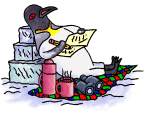|
 Astronomers
have made a prediction: On Tuesday morning, Nov. 19th, sky watchers
in Europe and North America will see hundreds or thousands of
meteors streak across the sky during the annual Leonid meteor
shower. A dazzling show! Astronomers
have made a prediction: On Tuesday morning, Nov. 19th, sky watchers
in Europe and North America will see hundreds or thousands of
meteors streak across the sky during the annual Leonid meteor
shower. A dazzling show!
But which is it? Hundreds of meteors? ...
or thousands?
You be the judge!
If you can count, you can help NASA decide
whose predictions are correct.
Before you rush outside to start counting,
however, there are a few procedures we need review to ensure
that the counts are scientifically meaningful. The number of
meteors you see depends on the light pollution in your area,
the altitude of the shower's radiant, whether or not the moon
is up, etc. All these need to be recorded so we can make sense
of the observations and compare results from different observers.
 Place a reclining chair (a lawn chair is
fine) in a dark site with an open view of the sky. Dress warmly!
You will also need a dim, red-filtered flashlight and a watch.
You can make notes with a notebook and a pencil, but a tape recorder
is even better. The recorder will allow you to dictate notes
in the dark without taking your eyes off the sky. Before you
start real observing, give your eyes ten minutes to adjust to
the dark. Place a reclining chair (a lawn chair is
fine) in a dark site with an open view of the sky. Dress warmly!
You will also need a dim, red-filtered flashlight and a watch.
You can make notes with a notebook and a pencil, but a tape recorder
is even better. The recorder will allow you to dictate notes
in the dark without taking your eyes off the sky. Before you
start real observing, give your eyes ten minutes to adjust to
the dark.
The full moon will be out on Nov. 19th.
Try not to stare at it--it will ruin your night vision. Instead,
look away from the moon toward a darker patch of sky.
Each time you see a meteor, make a check mark on your notepad
or a comment on the voice recorder. Every ten minutes note the
time. We've provided a printable
form that might come in handy for making the meteor counts.
For your counts to be meaningful it is absolutely necessary to
establish the "limiting magnitude" of your night sky.
In other words, what is the dimmest star you can see? One way
to check your limiting magnitude is to look at the constellation
Leo. The diagram below shows the magnitudes of twelve stars in
that constellation.

Done counting? Then it's time to submit
your data. Click on the links below to add your counts to the
NASA database:
Teachers Click Here
Students Click Here
Thanks for your help! |

 Astronomers
have made a prediction: On Tuesday morning, Nov. 19th, sky watchers
in Europe and North America will see hundreds or thousands of
meteors streak across the sky during the annual Leonid meteor
shower. A dazzling show!
Astronomers
have made a prediction: On Tuesday morning, Nov. 19th, sky watchers
in Europe and North America will see hundreds or thousands of
meteors streak across the sky during the annual Leonid meteor
shower. A dazzling show! Place a reclining chair (a lawn chair is
fine) in a dark site with an open view of the sky. Dress warmly!
You will also need a dim, red-filtered flashlight and a watch.
You can make notes with a notebook and a pencil, but a tape recorder
is even better. The recorder will allow you to dictate notes
in the dark without taking your eyes off the sky. Before you
start real observing, give your eyes ten minutes to adjust to
the dark.
Place a reclining chair (a lawn chair is
fine) in a dark site with an open view of the sky. Dress warmly!
You will also need a dim, red-filtered flashlight and a watch.
You can make notes with a notebook and a pencil, but a tape recorder
is even better. The recorder will allow you to dictate notes
in the dark without taking your eyes off the sky. Before you
start real observing, give your eyes ten minutes to adjust to
the dark.